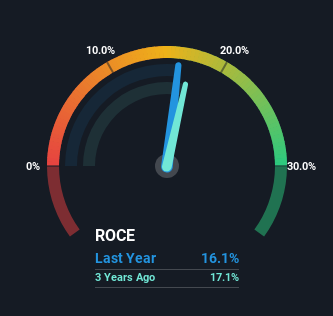- India
- /
- Specialty Stores
- /
- NSEI:EMIL
Returns On Capital Signal Tricky Times Ahead For Electronics Mart India (NSE:EMIL)

What are the early trends we should look for to identify a stock that could multiply in value over the long term? One common approach is to try and find a company with returns on capital employed (ROCE) that are increasing, in conjunction with a growing amount of capital employed. Put simply, these types of businesses are compounding machines, meaning they are continually reinvesting their earnings at ever-higher rates of return. Although, when we looked at Electronics Mart India (NSE:EMIL), it didn't seem to tick all of these boxes.
What Is Return On Capital Employed (ROCE)?
Just to clarify if you're unsure, ROCE is a metric for evaluating how much pre-tax income (in percentage terms) a company earns on the capital invested in its business. The formula for this calculation on Electronics Mart India is:
Return on Capital Employed = Earnings Before Interest and Tax (EBIT) ÷ (Total Assets - Current Liabilities)
0.16 = ₹3.3b ÷ (₹25b - ₹4.1b) (Based on the trailing twelve months to December 2023).
Thus, Electronics Mart India has an ROCE of 16%. That's a relatively normal return on capital, and it's around the 17% generated by the Specialty Retail industry.
See our latest analysis for Electronics Mart India

In the above chart we have measured Electronics Mart India's prior ROCE against its prior performance, but the future is arguably more important. If you'd like to see what analysts are forecasting going forward, you should check out our free analyst report for Electronics Mart India .
What Does the ROCE Trend For Electronics Mart India Tell Us?
When we looked at the ROCE trend at Electronics Mart India, we didn't gain much confidence. Around four years ago the returns on capital were 23%, but since then they've fallen to 16%. Although, given both revenue and the amount of assets employed in the business have increased, it could suggest the company is investing in growth, and the extra capital has led to a short-term reduction in ROCE. If these investments prove successful, this can bode very well for long term stock performance.
On a related note, Electronics Mart India has decreased its current liabilities to 17% of total assets. That could partly explain why the ROCE has dropped. Effectively this means their suppliers or short-term creditors are funding less of the business, which reduces some elements of risk. Since the business is basically funding more of its operations with it's own money, you could argue this has made the business less efficient at generating ROCE.
The Bottom Line
While returns have fallen for Electronics Mart India in recent times, we're encouraged to see that sales are growing and that the business is reinvesting in its operations. And long term investors must be optimistic going forward because the stock has returned a huge 194% to shareholders in the last year. So while the underlying trends could already be accounted for by investors, we still think this stock is worth looking into further.
Electronics Mart India does have some risks though, and we've spotted 1 warning sign for Electronics Mart India that you might be interested in.
While Electronics Mart India isn't earning the highest return, check out this free list of companies that are earning high returns on equity with solid balance sheets.
Valuation is complex, but we're here to simplify it.
Discover if Electronics Mart India might be undervalued or overvalued with our detailed analysis, featuring fair value estimates, potential risks, dividends, insider trades, and its financial condition.
Access Free AnalysisHave feedback on this article? Concerned about the content? Get in touch with us directly. Alternatively, email editorial-team (at) simplywallst.com.
This article by Simply Wall St is general in nature. We provide commentary based on historical data and analyst forecasts only using an unbiased methodology and our articles are not intended to be financial advice. It does not constitute a recommendation to buy or sell any stock, and does not take account of your objectives, or your financial situation. We aim to bring you long-term focused analysis driven by fundamental data. Note that our analysis may not factor in the latest price-sensitive company announcements or qualitative material. Simply Wall St has no position in any stocks mentioned.
About NSEI:EMIL
Electronics Mart India
Engages in the sale of consumer electronics and durable products in India.
Good value with reasonable growth potential.
Similar Companies
Market Insights
Community Narratives




